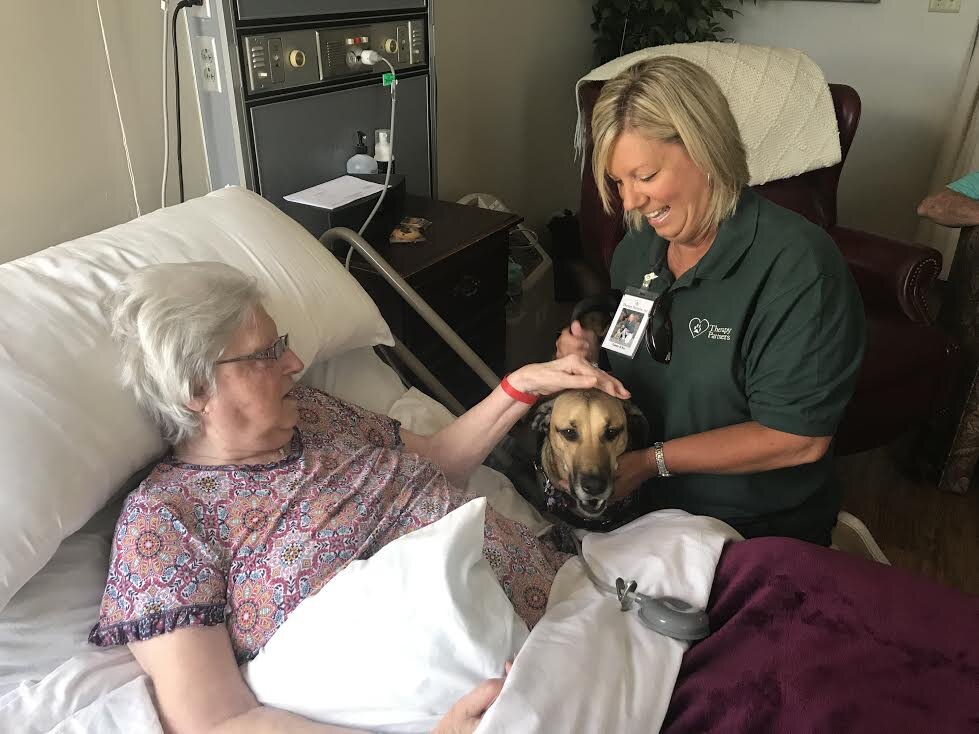
Animal Therapy Research
Research statistics compiled by Pet Partners, Inc.
Benefits of the Human-Animal Bond
The human-animal bond is a mutually beneficial and dynamic relationship between people and animals that positively influences the health and well-being of both. While many of us intuitively understand the benefits of positive interactions with animals in our lives, an emerging body of research is recognizing the impact the human-animal bond can have on individual and community health.
Examples of therapy animals improving the physical, social, and emotional health of clients:
A therapy dog has a positive effect on patients’ pain level and satisfaction with their hospital stay following total joint arthroplasty (Harper, 2014) [1].
Fibromyalgia patients spending time with a therapy dog instead of in an outpatient waiting area at a pain management facility showed significant improvements in pain, mood and other measures of distress (Marcus, 2013) [2].
A walking program that matched sedentary adults with therapy animals resulted in an increase in walking over a 52-week graduated intervention with the participants stating their motivation for adherence was “the dogs need us to walk them” (Johnson, 2010) [3].
The presence of an animal can significantly increase positive social behaviors among children with autism spectrum disorder (O’Haire, 2013) [4].
Children made fewer errors in match-to-sample categorization task in the presence of a dog relative to a stuffed dog or human (Gee, 2010) [5]. Similar studies may indicate presence of a dog serves as both a source of motivation and a highly salient stimulus for children, allowing them to better restrict their attention to the demands of the task (Gee, 2012) [6].
Therapy animals in pediatric cancer studies improved patient motivation to participate in treatment protocol, to maintain their motivation over time, and to want to “get better” or stay optimistic (Sobo, 2006)[13], (Barker, 2008)[14].
Benefits extend to our companion animals and the presence of pets in our lives:
Pet ownership, perhaps by providing social support, lowers blood pressure response to mental stress (Allen, 2001) [7].
Pet owners have higher one-year survival rates following heart attacks (Friedmann, 1980, 1995) [8,9].
Recognizing and nurturing the connection between animals and humans has potential implications for individual stability and health, improved economic outputs and healthcare cost savings (Takashima, 2014) [10]. This conclusion was based on a number of studies.
Pet ownership, particularly dog ownership, may be reasonable for reduction in cardiovascular disease risk (Levine, 2013) [11].
Pet ownership was associated with a reduced risk for Non-Hodgkin’s lymphoma and diffuse large cell lymphoma (Trahan, 2008) [12].
Human health savings of $3.86 billion over 10 years have been linked to pet ownership as related to a decrease in doctor visits in studies in Austria and Germany (Heady, 2002) [15].
Whether it is pet ownership that gives us cause to exercise, offers an antidote for loneliness, and gives us loving companions to care for; or animal-assisted interventions that improve motivation to participate in treatment and lessen worry, anxiety, and pain, we recognize that animals can influence not just our happiness but also our health.
Citations:
[1] Harper CM, Dong Y, Thornhill TS, et al. Can therapy dogs improve pain and satisfaction after total joint arthroplasty? A randomized controlled trial. Clinical Orthopaedics and Related Research® 2014;473(1):372-79.
[2] Marcus DA, Bernstein CD, Constantin JM, et al. Impact of Animal-Assisted Therapy for Outpatients with Fibromyalgia. Pain Medicine 2013;14(1):43-51.
[3] Johnson RA, Meadows RL. Dog-walking: Motivation for adherence to a walking program. Clinical Nursing Research, 19(4), 387-402
[4] O’Haire ME, McKenzie SJ, Beck AM, Slaughter V (2013). Social Behaviors Increase in Children with Autism in the Presence of Animals
Compared to Toys. PLoS ONE 8(2): e57010. Doi:10.1371/journal.pone.0057010
[5] Gee NR, Church MT, Altobelli CL. Preschoolers make fewer errors on an object categorization task in the presence of a dog. Anthrozoös
2010;23(3):223-30.
[6] Gee NR, Gould JK, Swanson CC, Wagner AK. Preschoolers categorize animate objects better in the presence of a dog. Anthrozoös
2012;25(2):187-198.
[7] Allen, K., Shykoff, B. E., & Joseph L. Izzo, J. (2001). Pet ownership, but not ACE inhibitor therapy, blunts home blood pressure responses
to mental stress. Hypertension, 38, 815-820.
[8] Friedmann, E., Katcher, A. H., Lynch, J. J., & Thomas, S. A. (1980). Animal companions and one-year survival of patients after discharge
from a coronary care unit. Public Health Reports, 95(4), 307-312.
[9] Friedmann, E., & Thomas, S. A. (1995). Pet ownership, social support, and one-year survival after acute myocardial infarction in the
Cardiac Arrhythmia Suppression Trial (CAST). The American Journal of Cardiology, 76(17), 1213-1217.
[10] Takashima GK, Day, MJ, (2014). Setting the one health agenda and the human-companion animal bond. Int. J. Environ. Res. Public
Health 2014, 11, 11110-11120; doi:10.3390/ijerph111111110
[11] Levine,G.N. ;Allen,K.; Braun,L.T.; Christian, H.E.; Friedmann, E.;Taubert,K.A.; Thomas, S.A.; Wells, D.L.; Lange, R.A. Pet ownership and
cardiovascular risk: A scientific statement from the American Heart Association. Circulation 2013, 127, 2353–2363.
[12] Trahan, G.J.; Bracci, P.M.; Holly, E.A. Domestic and farm-animal exposures and risk of non-hodgkin’s lymphoma in a population-based
study in San Francisco bay area. Cancer Epidemiol. Biomark. Prev. 2008, 17, 2382–2387.
[13] Sobo, E.J.; Eng, B.; Kassity-Krich, N. Canine Visitation (Pet) Therapy: Pilot study data on decrease in child pain perception. J. Holist.
Nurs. 2006, 24, 51–57.
[14] Barker, S.B.; Wolen, A.K. The benefits of human-companion animal interaction: A review. J. Vet. Med. Ed. 2008, 35, 487–495.
[15] Heady, B.; Grabka, M.; Kelley, J.; Reddy, P.; Tseng, Y.-P. Pet ownership is good for your health and saves public expenditure too. Australian and German longitudinal evidence. Aust. Soc. Monit. 2002, 5, 93–99.

